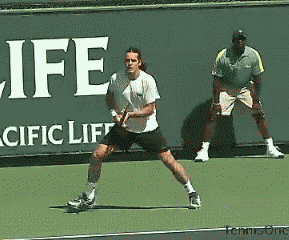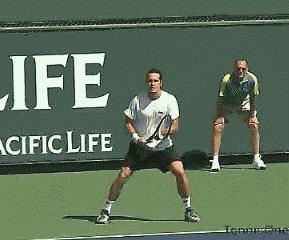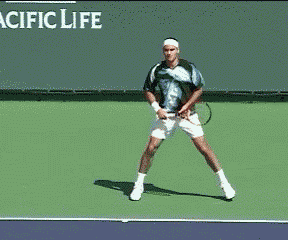| TennisOne Lessons Defining Professional Stroke Patterns David W. Smith, Senior Editor TennisOne When tennis enthusiasts visit a professional tournament, especially one like the Pacific Life Open in Indian Wells, California, initial impressions usually involve subjective observations like being awed by the footwork speed of nearly all pros or impressed with the power of their serves or groundstrokes. Certainly, the close proximity of the pros to the fans gives tennis aficionados a real taste of life at the top of the game; for many first-time visitors, it can literally be a moving, memorable event. Let's face it, tennis on television (high definition not withstanding), just doesn't do it. And few tennis venues allow fans to get as close to the pros as the Pacific Life Open, especially on the practice courts. Interestingly enough, many of my students, after watching these pros hit, seem to have a strong desire to go out and play. And many of the same people tell me they play some of their best tennis, after watching professionals and there amazing arsenal of weapons. So, why is it that we seem play so well after watching the pros?
Watching the typical club player, you will often see two or three different swings, usually based on their position relative to the ball and their balance, (or lack there of!). Even when pressed to return a difficult ball, the pros are able to move, set up and stroke the ball with a using the same swing pattern as if they have routinely hit that same shot hundreds of times (which, of course, they have)! You must remember that aiming in tennis involves three dimensions: Height, depth, and lateral direction. Too high, too low, too far left or right, too short, or too deep all will result in an error. So, if your swing changes on every hit, aiming becomes extremely problematic. For example, let’s assume you hit with a racquet face that “rolls” from open to closed and hit it late. The result will be a ball hit too long. If you aim lower, but you hit the ball earlier, your ball goes into the bottom of the net. Based on this second swing, you should have aimed higher not lower!
Body position/Balance: This second component of a good swing is often generalized under the category of “footwork.” Because footwork determines the position at contact as well enabling proper balance, players who don’t move appropriately or effectively will end up in a inferior position to strike the ball even if they have a great swing pattern. Positioning oneself too far from the ball or too close, or if a ball is too far out in front or hit too late, the resulting direction inconsistent …significantly different in many situations! Watching the pros up close, you can get a real feel for this movement: the persistent “chirping” of tennis shoes screeching around the court is a constant reminder of all these steps the pros are executing in every single rally.
The idea is to create a start and finish to every shot. In addition, by intentionally moving so that you know you will hold your finish, you will hit with better balance and body control. One of the biggest faults I see among recreational players is their inability to stay balanced on most of their strokes. Granted, there will be shots you simply have to run for and won’t be able to hold any finish. However, most players move minimally and reach for the ball, causing their center of gravity to be well off during and after each swing. If you watch the pros, even at the high speeds of their shots and the speed of having to react to an opponent’s shot, you will see them hold their finish in most all situations. If you work on moving with the intention of holding your finish, you too will be well on your way to playing much better tennis! Conclusion A lot of people don’t believe that watching pros or emulating professional level strokes can be helpful. In my opinion, this is far from the truth. In fact, for the most part, while pros swing with significant force, their stroke mechanics are usually very sound and efficient. But, more importantly, they exhibit more discipline in their stroke mechanics and you can see that very clearly in watching them up close. However, even up close, observers can miss many of these stroke nuances and key points. Using high-speed video analysis like that found on TennisOne can make the invisible visible and the processes understandable. Your comments are welcome. Let us know what you think about Dave Smith's article by emailing us here at TennisOne .
TENNIS MASTERYFinally. a resource that unlocks these mysteries: • Why do m • Why are making changes in one's game so frustratingly difficult? • What tennis teaching methods are disruptive or detrimental to player progression? Read David W. Smith's TENNIS MASTERY and learn not just how to avoid playing at mediocre levels, but how the best players in the world Master the sport of tennis! "With a depth of knowledge and fresh perspective, TENNIS MASTERY is set to become a manual for tennis instructors and a measure for tennis literature." Richard Wigley, Director, Kayenta Tennis Center, Ivins Utah. Take in David Smith's 30 plus years in the tennis teaching industry. This 335-page manual will provide for every level of player as well as support for all tennis-teaching professionals, a blueprint for reaching higher levels of tennis mastery. Order TENNIS MASTERY at tenniswarehouse.com , or go to tennismastery.net for exciting excerpts from the book and a host of tennis information! And check out David Smith's other articles found here at TennisONE.com |




 illions of tennis players stagnate at levels far below their potential?
illions of tennis players stagnate at levels far below their potential?